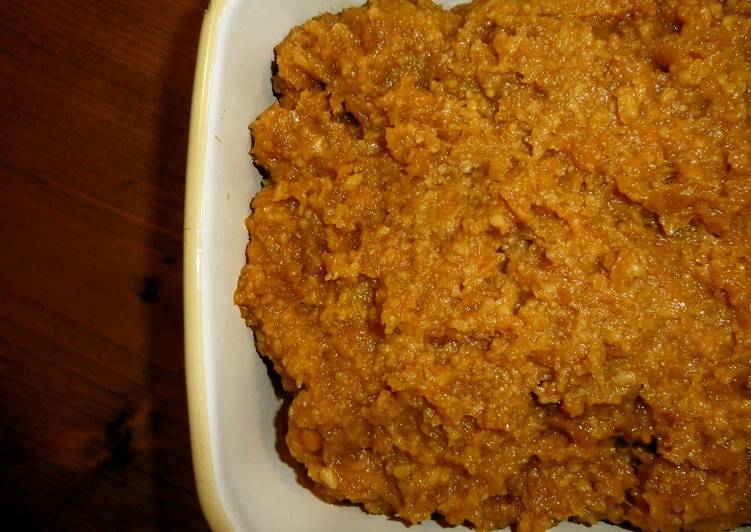Hey everyone, welcome to my recipe site, looking for the perfect Homemade Miso Using a Pressure Cooker recipe? look no further! We provide you only the best Homemade Miso Using a Pressure Cooker recipe here. We also have wide variety of recipes to try.

Before you jump to Homemade Miso Using a Pressure Cooker recipe, you may want to read this short interesting healthy tips about Foods That Make Your Mood Better.
Many of us think that comfort foods are not good for us and that we have to stay away from them. At times, if your comfort food is candy or another junk food, this is very true. Otherwise, comfort foods can be super nutritious and good for you. There are several foods that, when you eat them, can better your mood. If you seem to be a little bit down and you’re needing an emotional pick me up, try some of these.
Cold water fish are great for eating if you wish to combat depression. Cold water fish like tuna, trout and wild salmon are rich in DHA and omega-3s. Omega-3 fatty acids and DHA are two things that actually help the grey matter in your brain work a lot better. It’s the truth: eating tuna fish sandwiches can really help you battle your depression.
Now you realize that junk food isn’t necessarily what you have to eat when you are wanting to help your moods get better. Test out these suggestions instead!
We hope you got insight from reading it, now let’s go back to homemade miso using a pressure cooker recipe. To cook homemade miso using a pressure cooker you only need 3 ingredients and 22 steps. Here is how you cook it.
The ingredients needed to make Homemade Miso Using a Pressure Cooker:
- Prepare 2 3/5 kg Fresh rice malt (nama koji)
- You need 1 3/5 kg Soy beans
- Provide 800 grams Salt
Instructions to make Homemade Miso Using a Pressure Cooker:
- Rinse the soy beans, and soak them in plenty of water overnight. They will swell up to twice their size by the next day.
- Put the soy beans into twice their volume of water in a pressure cooker and bring to a boil. Skim off the white scum that rises to the surface.
- Put the perforated metal plate that comes with the pressure cooker on top. Lock the lid on and cook under pressure for 10 minutes, then leave to cool down naturally. *If you have a small pressure cooker, cook the soy beans in 2 batches.
- This is the fresh rice koji I ordered by mail and used this time. There are 2 bags containing 1.3 kg each. You can use dried rice koji instead!
- While the soy beans are cooking, mix the koji and salt together.
- Drain the cooking liquid from the cooked soy beans, and hold onto it to use later. *If you're cooking the soy beans in several batches, just keep the cooking liquid from the final batch.
- Let the soy beans cool a bit, and put them in a plastic bag. They'll be hot so wrap the bag in a towel and press down with your hands to mash them. The beans are very soft so this should be easy.
- Add the combined koji and salt from Step 5 to the mashed soy beans and mix well. Mix in some of the cooking liquid until the paste is about the consistency of hamburger mixture or about as soft as your earlobe.
- Line a large container or tub with a double layer of plastic bags. Roll the paste into apple sized balls (these are called miso balls) and throw them hard into the container. Press them in firmly to eliminate any air pockets.
- When all the miso balls have been put into the container, press down hard on the whole mass again while putting your weight into it to remove any air. Sprinkle a handful of salt on top evenly. (This is to prevent the surface from developing mold.)
- Squeeze the inner plastic bag closed while pushing out any air inside. Press a small lid or plate on top, add a weight on top of that and wrap and close the outer plastic bag over all. Cover with a lid.
- Wrap the whole container with another plastic bag. Leave it in a dark, cool place out of the sun.
- Here's the schedule from this point on:
- Mixing up from the bottom (1st time): Check on the miso after about 2 months to see if it has developed any mold! If it has, just remove the parts with the mold. Mix the whole thing up from the bottom after removing the moldy parts.
- Mixing up from the bottom (2nd time): Open up the miso 4 months after the first time you mixed it up! Mix it up from the bottom again.
- If the miso has matured enough when you mix it up the 2nd time you can start eating it, but it will become more delicious if you let it mature for a while longer.
- I made miso this time on February 3rd, the day of spring (Setsubun no Hi). I'm looking forward to how it will turn out.
- April 30th: The first mixing up! It's about 3 months after I made the miso. I opened the lid slowly since I was afraid it had developed mold.
- Looks so good! It's fluffy, and actually starting to smell like miso! It hadn't molded at all as I'd feared, and it's turned into miso. It's not yet edible at this point, though.
- I mixed it up from the bottom. To do this I took the plastic bag out and squeezed the miso over the bag. This way my hands are not in direct contact with the miso, so no bacteria gets into it.
- I returned the plastic bag to the container, and levelled out the surface with a wooden spatula. I closed up the plastic bags again as described above. I left it in a cool, dark place. I'll check on it again in September…maybe it will be ready to eat by then…
- End of August: It's matured into a delicious looking miso. It's ready to eat at this point. The top photo is of the miso at this stage.
If you find this Homemade Miso Using a Pressure Cooker recipe helpful please share it to your good friends or family, thank you and good luck.


